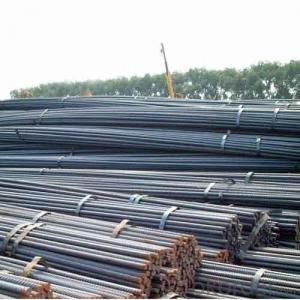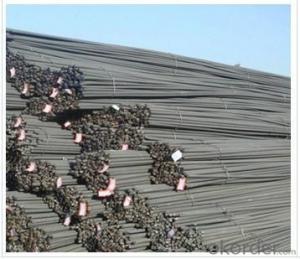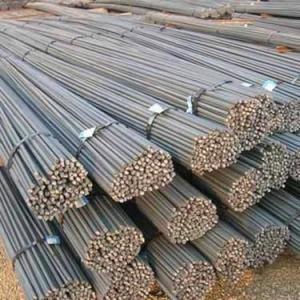BS4449-1997 deformed steel bar for construction
- Loading Port:
- Tianjin
- Payment Terms:
- TT or LC
- Min Order Qty:
- 25 m.t.
- Supply Capability:
- 100000 m.t./month
OKorder Service Pledge
OKorder Financial Service
You Might Also Like
Product Description:
OKorder is offering BS4449-1997 deformed steel bar for construction at great prices with worldwide shipping. Our supplier is a world-class manufacturer of steel, with our products utilized the world over. OKorder annually supplies products to European, North American and Asian markets. We provide quotations within 24 hours of receiving an inquiry and guarantee competitive prices.
Product Applications:
BS4449-1997 deformed steel bar are ideal for structural applications and are widely used in the construction of buildings and bridges, and the manufacturing, petrochemical, and transportation industries.
Product Advantages:
OKorder's deformed steel bar are durable, strong, and resist corrosion.
Main Product Features:
· Premium quality
· Prompt delivery & seaworthy packing (30 days after receiving deposit)
· Corrosion resistance
· Can be recycled and reused
· Mill test certification
· Professional Service
· Competitive pricing
Product Specifications:
Specifications of Middle Specification Steel Bar
1. Grade: Q235, SS400, A36, S235JR (With Boron)
2. Standard: GB, JIS, ASTM, BS
3. Diameter: 17mm—40mm
4. Length: As customer’s request, but we usually produce 6m and 12m.
5. Steel Grade: Carbon steel
6. Technique: Hot rolled or cold drawn
7. Inspection: SGS; ISO 9001:2000
8. Details about mass
Diameter | Mass | Diameter | Mass |
(mm) | (kg/m) | (mm) | (kg/m) |
17 | 1.78 | 26 | 4.17 |
18 | 2.00 | 28 | 4.83 |
19 | 2.23 | 30 | 5.55 |
20 | 2.47 | 32 | 6.31 |
22 | 2.98 | 34 | 7.13 |
24 | 3.55 | 36 | 7.99 |
25 | 3.85 | 38 | 8.90 |
Usage and Applications of Middle Specification Steel Bar
1. Middle specification steel bar is often used inconstruction and a large number of architectural and engineering structures.
2. And we can use this kind of product on the performance of the mechanical parts if the demand is not very high.
3. Some especial material steel round bar can be used for main shaft of steamer, hummer shank, with big section and supper force.
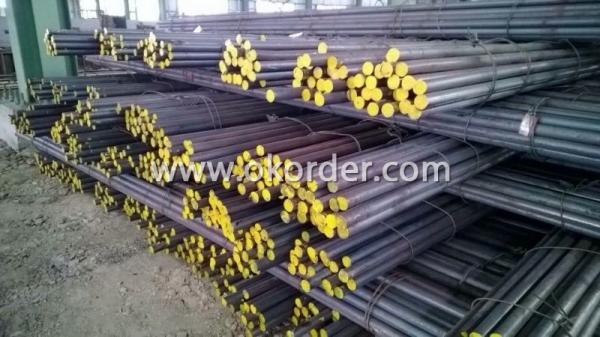
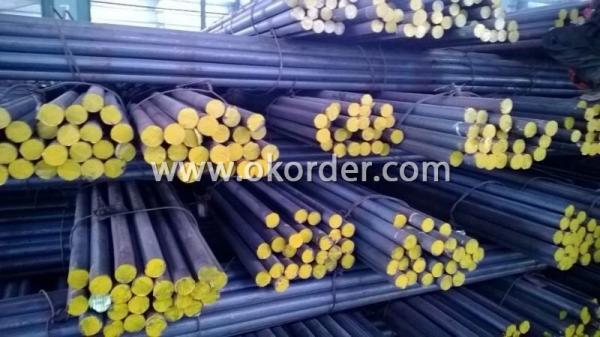
Packaging & Delivery of Middle Specification Steel Bar
Packaging Detail: All goods are packed in bundle with steel strips and shipped by break bulk vessel or container (depend on target market and different ports)
Delivery Detail: 45 days
Trade terms: FOB, CFR, CIF
MOQ: 25 tons per specification; we can negotiate the quantity if the specification is normal or we have stock of one specification.
Weight: Theprice invoicing on theoretical weight basis or actual weight basis depends on customer’s request.
Shipment: The shipment of bulk break or container is depends on customer’s request and the situation of the port of destination.
Documents given: Full set of original clean on board bill of lading; Original signed commercial invoice; Original packing list; Policy of insurance; Certificate of origin and what the target market needs.
Note: a. FOB Jinzhou can be USD 10 cheaper than FOB Tianjin. b. The risk of the commodity shall be transferred to the buyer from the moment of the commodity be loaded on board.
Production Flow of Middle Specification Steel Bar
We use advanced equipments like Electric Arc Furnace, Ladle Furnace and Vacuum Degasser to produce our products.
Our process is EAF+LF+VD+ Forged+ Heat Treatment
The flow of fabrication is Material prepare (billet) — heat up — rough rolling — precision rolling — cooling — packing — storage and transportation
Quality Assurance of Middle Specification Steel Bar
1. We will strictly inspect our production that we sold according to the customer’s request.
2. Quality should be in conformity with the specification of the manufacturer. Quantity and packing conditions should be in conformity with the term in the contract.
3. Should the packing found damaged, the buyer has the right to claim to the seller.
FAQ:
FAQ:
Q1: Why buy Materials & Equipment from OKorder.com?
A1: All products offered byOKorder.com are carefully selected from China's most reliable manufacturing enterprises. Through its ISO certifications, OKorder.com adheres to the highest standards and a commitment to supply chain safety and customer satisfaction.
Q2: How do we guarantee the quality of our products?
A2: We have established an advanced quality management system which conducts strict quality tests at every step, from raw materials to the final product. At the same time, we provide extensive follow-up service assurances as required.
- Q:What are the advantages of using fiber-reinforced polymer (FRP) rebars over steel rebars?
- Using fiber-reinforced polymer (FRP) rebars instead of traditional steel rebars in construction projects offers several advantages: 1. Superior corrosion resistance: FRP rebars do not corrode like steel rebars, which are prone to rust and deterioration when exposed to moisture and chemicals. This property significantly enhances the durability and lifespan of structures, especially in harsh environmental conditions. 2. Lightweight nature: FRP rebars are significantly lighter than steel rebars, making them easier to handle, transport, and install. This lightweight characteristic also reduces the overall dead load of a structure, allowing for more efficient design and construction. 3. Impressive strength-to-weight ratio: Despite being lightweight, FRP rebars possess a high strength-to-weight ratio, enabling them to bear heavy loads while maintaining their structural integrity. This quality makes FRP rebars ideal for applications where weight reduction is desired without compromising strength, such as in bridge decks and seismic reinforcement. 4. Non-magnetic and non-conductive properties: Unlike steel rebars, FRP rebars are non-magnetic and non-conductive. This feature proves advantageous in structures that require non-magnetic properties, like MRI rooms in hospitals, or situations where electrical conductivity needs to be minimized, such as in power plants or near electrical equipment. 5. Flexibility in design: FRP rebars can be manufactured in various shapes and sizes, offering design flexibility and customization options to meet specific project requirements. They can be easily cut and shaped on-site, allowing for seamless integration into complex geometries and curved structures. 6. Thermal compatibility: FRP rebars possess a low coefficient of thermal expansion, meaning they expand and contract at a similar rate to the surrounding concrete. This thermal compatibility reduces the risk of cracking and ensures better long-term performance of the structure, especially in areas with extreme temperature variations. 7. Outstanding durability: FRP rebars exhibit excellent long-term durability, even in aggressive environments. They are resistant to alkalis, chemicals, and UV radiation, ensuring their performance and structural integrity over an extended period. 8. Environmentally friendly: FRP rebars are considered more environmentally friendly than steel rebars due to their minimal carbon footprint. They require less energy to produce and generate fewer greenhouse gas emissions during manufacturing. Additionally, FRP rebars are non-toxic and do not pose a threat to the environment during their lifespan or at the end of their service life. Overall, the benefits of using FRP rebars make them a viable alternative to steel rebars in various construction applications. They offer improved durability, lightweight design, corrosion resistance, and enhanced structural performance.
- Q:How do steel rebars affect the overall seismic performance of a structure?
- Steel rebars play a crucial role in improving the overall seismic performance of a structure. By reinforcing concrete elements, such as beams, columns, and slabs, rebars enhance the structural integrity and ductility of the building. This means that during an earthquake, the rebars help the structure withstand the lateral forces and deformations, minimizing the risk of collapse. Additionally, the presence of rebars improves the energy dissipation capacity of the structure, allowing it to absorb and dissipate seismic energy, further enhancing its resilience.
- Q:How do steel rebars improve the flexural strength of concrete?
- Steel rebars improve the flexural strength of concrete by providing tensile strength, which is typically lacking in concrete. The rebars act as reinforcement, absorbing the tension forces that occur when the concrete is subjected to bending or flexing. This combination of concrete and steel rebars creates a composite material that is stronger and more resistant to cracking or breaking under flexural loads.
- Q:What are the typical costs associated with using steel rebars in a construction project?
- The costs of utilizing steel rebars in a construction venture can differ based on various elements. These elements incorporate the size and type of the rebar, the amount required, the market conditions, and the project's location. Typically, the expense of steel rebars is calculated per ton or per linear foot. The cost per ton can fluctuate between $400 and $600, while the cost per linear foot can range from $0.75 to $1.50. It is important to note that these prices are approximate and subject to change based on market demand and availability. Furthermore, there might be additional expenses related to the acquisition and handling of steel rebars. These expenses can include transportation fees, storage costs, and the necessary equipment or tools required for installation. Other cost considerations may involve labor costs for cutting, bending, and placing the rebars, as well as any reinforcement detailing required according to the project's design specifications. These costs can vary depending on the project's complexity and the skill level of the laborers involved. It is also crucial to account for any potential wastage or scrap materials that may arise during the construction process. Proper planning and accurate measurements can help minimize these costs. In general, the typical costs connected with utilizing steel rebars in a construction project can be substantial, but they are necessary to ensure structural integrity and reinforcement. It is advisable to obtain quotes from multiple suppliers and contractors to ensure competitive pricing and carefully consider the project's specific requirements before finalizing the budget.
- Q:How do steel rebars affect the overall longevity of a structure?
- Steel rebars, also known as reinforcement bars, play a crucial role in enhancing the overall longevity of a structure. By providing strength and durability, rebars reinforce the concrete, making it more resistant to cracking and structural failure. This reinforcement ensures that the structure can withstand various external forces, such as extreme weather conditions, seismic activity, and heavy loads. Consequently, the use of steel rebars significantly extends the lifespan of a structure, ensuring its long-term stability and safety.
- Q:Are steel rebars resistant to extreme temperatures?
- Yes, steel rebars are generally resistant to extreme temperatures. Steel has a high melting point and does not easily deform or degrade under high or low temperatures. However, if exposed to extremely high temperatures for prolonged periods, steel rebars may lose some of their strength and structural integrity.
- Q:How are steel rebars stored and handled on construction sites?
- Steel rebars are typically stored in designated areas on construction sites to ensure easy access and organization. They are often stacked horizontally and secured with supports to prevent them from rolling or falling. When handling rebars, workers wear appropriate protective gear and use equipment such as cranes or forklifts to lift and move them safely. Additionally, rebars are carefully inspected for any defects or damages before being used in construction projects.
- Q:Can steel rebars be used in modular construction?
- Yes, steel rebars can be used in modular construction. Steel rebars are commonly used as reinforcement in concrete structures, including those found in modular construction. They provide strength and durability to the modular units, ensuring their stability and structural integrity.
- Q:What is the lifespan of steel rebars in marine structures?
- The durability of steel rebars in marine structures can vary due to several factors, including the quality of the steel, the environmental conditions they are exposed to, and the maintenance strategies employed. However, marine structures that are designed, constructed, and maintained appropriately can typically endure for 50 to 100 years. Typically, steel rebars used in marine structures are coated with corrosion-resistant materials, like epoxy or zinc, to shield them from the harsh marine environment. These coatings serve as an extra layer of protection, extending the lifespan of the rebars. Nevertheless, it is crucial to acknowledge that the marine environment is highly corrosive due to the presence of saltwater, humidity, and other corrosive agents. Over time, these elements can cause the deterioration of the protective coatings, exposing the rebars to corrosion. Without adequate maintenance measures, such as regular inspections, cleaning, and reapplication of protective coatings, the rebars may experience accelerated corrosion, leading to a shortened lifespan. Furthermore, the design and construction of marine structures play a critical role in determining the lifespan of steel rebars. It is essential to carefully consider factors like structural design, material selection, and detailing to minimize the risk of corrosion and ensure the longevity of the rebars. To summarize, the lifespan of steel rebars in marine structures can vary from 50 to 100 years based on factors such as steel quality, environmental conditions, and maintenance practices. Proper design, construction, and maintenance are crucial for maximizing the lifespan of steel rebars in marine structures.
- Q:What is the process of removing steel rebars from concrete structures?
- The process of removing steel rebars from concrete structures involves several steps to ensure the safe and efficient removal of these reinforcement bars. 1. Assessment: Before starting the removal process, a thorough assessment of the concrete structure needs to be conducted. This includes evaluating the type and condition of the rebars, the integrity of the surrounding concrete, and any potential risks or obstacles that may affect the removal process. 2. Preparation: Once the assessment is completed, necessary preparations are made to ensure the safety of the workers and the surrounding environment. This may involve wearing personal protective equipment, setting up barricades or safety barriers, and securing the area to prevent any accidents or injuries. 3. Cutting: The next step is to cut the steel rebars. This can be done using various techniques such as oxyacetylene cutting, saw cutting, or using specialized cutting tools like rebar cutters or shears. The cutting method used depends on the size and thickness of the rebars, as well as the accessibility of the area. 4. Extraction: After the rebars are cut, they need to be extracted from the concrete structure. This can be done manually using pry bars or mechanical methods such as using cranes, excavators, or hydraulic breakers. The extraction process should be done carefully to avoid damaging the surrounding concrete or causing any structural instability. 5. Cleaning and Restoration: Once the rebars are removed, the area needs to be cleaned of any debris or leftover material. This is important to ensure a safe working environment for any subsequent construction or renovation work. Additionally, any damage caused to the concrete structure during the removal process should be repaired or restored to maintain its structural integrity. It is important to note that the process of removing steel rebars from concrete structures should be carried out by trained professionals with expertise in construction and demolition. It is also essential to comply with local regulations and safety guidelines to prevent accidents, minimize environmental impact, and preserve the integrity of the concrete structure.
1. Manufacturer Overview |
|
|---|---|
| Location | |
| Year Established | |
| Annual Output Value | |
| Main Markets | |
| Company Certifications | |
2. Manufacturer Certificates |
|
|---|---|
| a) Certification Name | |
| Range | |
| Reference | |
| Validity Period | |
3. Manufacturer Capability |
|
|---|---|
| a)Trade Capacity | |
| Nearest Port | |
| Export Percentage | |
| No.of Employees in Trade Department | |
| Language Spoken: | |
| b)Factory Information | |
| Factory Size: | |
| No. of Production Lines | |
| Contract Manufacturing | |
| Product Price Range | |
Send your message to us
BS4449-1997 deformed steel bar for construction
- Loading Port:
- Tianjin
- Payment Terms:
- TT or LC
- Min Order Qty:
- 25 m.t.
- Supply Capability:
- 100000 m.t./month
OKorder Service Pledge
OKorder Financial Service
Similar products
New products
Hot products
Related keywords
